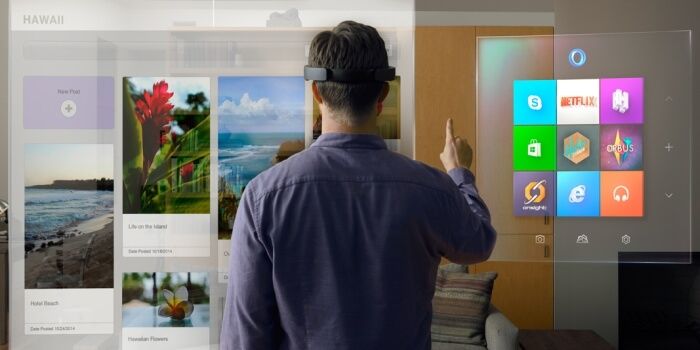Gamers have been promised many things over the years, with manufacturers and developers claiming that the next technological breakthrough was just around the corner, certain to break down even more walls between users and entertainment than ever before. Those same claims are being made by Microsoft as it reveals its plan for Windows 10, with particular attention paid to one form of tech sure to make every science fiction fan rejoice: Holograms.
That's right, holograms. Microsoft has released today the "new generation of Windows," committing to breaking down the barriers between PC and the Xbox One, in particular. But as Oculus Rift and Sony attempt to bring VR headsets into the world of video games, Microsoft looks to bring holographic technology into its entire operating system. The project (known as Windows Holographic) is still in development, but is aiming to redefine much more than just video games.
The technology relies on a system known as HoloLens, relying on a headset not entirely unlikely the Oculus Rift. Divisions have already been forming between major manufacturers about which technology holds greater promise - virtual reality, or augmented reality - and it seems Microsoft is putting its weight behind the latter.
The HoloLens' ability to project Windows 10 apps into virtual space around the user may seem more like a prototype version of Minority Report's signature special effect than a realistic tool, but Windows confirms that the concept images are just a sign of what could be possible once the technology progresses:
It was a special moment this morning when we were able to share that Windows 10 is the world’s first holographic computing platform – complete with a set of APIs that enable developers to create holographic experiences in the real world. With Windows 10, holograms are Windows universal apps and Windows universal apps can work as holograms, making it possible to place three-dimensional holograms in the world around you to communicate, create and explore in a manner that is far more personal and human.
Showcasing the possibilities of holograms in Windows 10, Microsoft HoloLens is the world’s first untethered holographic computer – no wires, phones or connection to a PC needed. Microsoft HoloLens allows you to view holograms in high definition and hear them in surround sound, even if they are behind you. And with advanced sensors, Microsoft HoloLens can see what you are looking at and understand what you are communicating with your hands and voice. By putting you at the center of the Windows 10 computing experience, Microsoft HoloLens allows you to create, access information, enjoy entertainment, and communicate in new and exciting ways.
The applications for the app are seemingly endless, with a tailored program known as Holo Studio even able to turn created holograms into 3D printed models.
[gallery link="file" columns="2" ids="249845,249848,249849,249850"]
The idea of using a headset (equipped with directional sound) to merge digital apps with the user's environment seems a more achievable goal than ones previously stated by the company (to turn ever surface in a person's home into an interactive computer screen). And using programs like Skype and Minecraft to showcase the possibilities, Microsoft seems as determined as ever to court consumers of games, music, movies, and any other media one could imagine.
The product is clearly a ways away from wide release or even Beta testing, but if the overall goal is to make Windows 10 appealing to PC users and gamers, then it does the trick. However, this isn't the first time that consumers have been shown jaw-dropping concept images that convince them a techno-revolution is on its way - only to be left wondering what went wrong a few months (or years later). Given the fickle nature of gaming as a whole (and the fact that Oculus VR is still finding its way towards mainstream use) perhaps it's wise for Microsoft to target less game-focused applications as well.
What do you make of Windows Holographic? Is it less intriguing to you than completely VR headsets, or does this seem like a step forward in ways you'd be more likely to use? Share your thoughts in the comments, and stay tuned to the site as more Windows 10 announcements are revealed.
Source: Windows Blog

